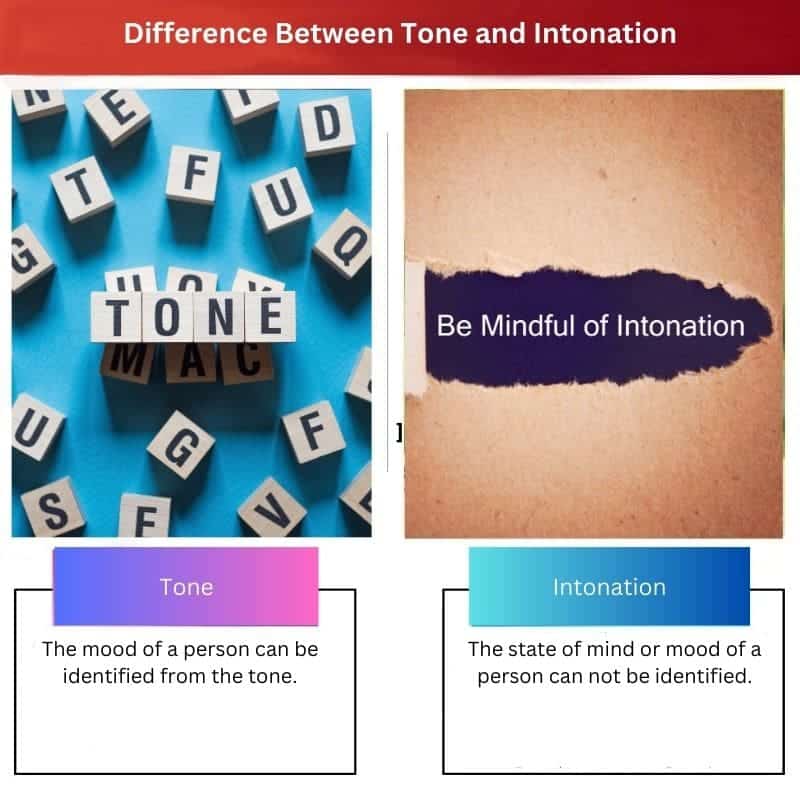Tone and intonation are frequently misunderstood in the universe and study of languages or linguistics. This misunderstanding may have emerged as a result of several other ideas in linguistics, semantics, and phonetics, such as word stress and volume.
In contrast, intonation is more of a voice fluctuation. It is defined as the upward or downward movement of the sound or voice due to its fluctuation.
Key Takeaways
- Tone refers to a spoken word’s pitch or musical quality, while Intonation refers to a sentence or phrase’s rising and falling pitch.
- The tone is used to convey the speaker’s attitude, emotion, or intention, while Intonation is used to convey the speaker’s meaning or emphasis.
- The tone is used in individual words, while Intonation is used in longer phrases or sentences and can vary depending on the speaker’s native language or regional accent.
Tone vs Intonation
Tone refers to the pitch, or level of vocalization, used when speaking, used to convey emotions, attitudes, or emphasis on particular words. Intonation refers to the rise and fall of a pitch during the speech, used to indicate questions or statements, and can also convey the overall meaning of a sentence.

The tone in which a person utters his words or sentences can reveal his or her state of mind or emotion. Voice patterns are unimportant to tone. Tone languages are constrained to fixed pitch objectives and are used to differentiate every word spoken.
Tone languages include Thai, Japanese, Swedish, Cantonese, and Mandarin on a global scale. Checking the intonation of a voice will not reveal a person’s mental state. The vocal patterns and intonation go hand in hand.
Intonation languages are quite particular about which words they employ to communicate meaning and use pitch semantically. Intonation languages, such as French, German, Spanish, and English, account for most languages spoken worldwide.
Comparison Table
| Parameters of Comparison | Tone | Intonation |
|---|---|---|
| What it reads | Deep attitude and emotions. | Change or fluctuations invoice. |
| State of mind | The mood of a person can be identified from the tone. | The state of mind or mood of a person can not be identified. |
| Voice patterns | Not concerned with voice patterns. | Closely concerned with the pattern invoice. |
| Studies and stress | Studies fixed-pitch targets and differentiate every spoken word. | Studies pitch semantically and emphasize every word. |
| Global distribution | Mandarin, Thai, Japanese, Swedish, Cantonese. | English, French, German, Spanish. |
What is Tone?
Deep attitudes and feelings are included in the tone. The tone with which a person utters his words or sentences can reveal his or her mental state or attitude. Voice patterns are unimportant in terms of tone.
Tone languages are constrained to fixed pitch objectives and are used to differentiate every word spoken. Thai, Japanese, Swedish, Cantonese, and Mandarin are examples of tone languages on a worldwide scale.
Tone refers to how someone expresses themselves through their words. You can tell whether someone is joyful or sad by their tone. Because your emotions greatly impact your tone, we may say that it is a more pragmatic aspect of communication.
A sentence’s meaning can be completely altered by changing one’s tone. When someone feels unhappy or annoyed, this is most visible. Perhaps they’re being sarcastic, and you can tell by their tone whether it’s mocking or not.
The tone is crucial in practical communication since it helps establish your meaning. When communicating, it’s critical to remember to use the appropriate tone.

What is Intonation?
Intonation refers to the variation or fluctuations invoice when a sentence is pronounced. Checking the intonation of a voice does not reveal a person’s mental condition. Intonation is intertwined with vocal rhythms.
Intonation languages are quite particular about the words they choose to communicate a meaning, and they also employ pitch semantically. Most languages spoken worldwide are intonation languages, including French, German, Spanish, and English.
When a person asks something or lets it be a question, then their voice frequently ends the sentence on a higher note. However, while congratulating someone in their happy times, the intonation is considered a positive affirmation.
The tone is the way we transmit emotion through our words. Instead, intonation is intimately tied to how we talk and aids in defining the meaning of what we say. Correct intonation might also help you communicate more effectively.

Main Differences Between Tone and Intonation
- Tone includes a deep attitude and emotions. On the other hand, Intonation refers to the change or fluctuations in voice when a sentence is spoken.
- The state of mind or mood can be known from the tone in which a person utters his words or sentences. On the other hand, the state of mind can not be identified by checking the intonation of a voice.
- The tone is not concerned with voice patterns. On the other hand, intonation works closely with the voice patterns.
- Tone languages are used to differentiate every word spoken and are limited to fixed pitch targets. On the other hand, Intonation languages are highly specific in choosing words to convey a message, and they use pitch semantically as well.
- On the global level, examples of tone languages are Thai, Japanese, Swedish, Cantonese, and Mandarin. On the other hand, the maximum of the languages spoken worldwide are intonation languages, such as French, German, Spanish, and English as well.

- https://www.karger.com/Article/Abstract/259793
- https://books.google.com/books?hl=en&lr=&id=TK62rcXEsNAC&oi=fnd&pg=PR11&dq=tone+and+Intonation&ots=MzqFlF4i5H&sig=sSC7ULM2VCHIv51OZf0o0Cph2ss

The comparison between tone and intonation was elucidated effectively in the article, providing a comprehensive understanding of their differences and implications in communication. The real-world examples of tone and intonation languages were particularly helpful.
The content and explanation of tone and intonation were very informative and well-structured. This article was a great resource for understanding the distinctions and applications of both in communication.
The article effectively compared and contrasted tone and intonation, shedding light on their nuanced differences and the significance of each in communication. I found the explanation of tone and intonation in practical communication to be particularly compelling.
The detailed comparison and explanation of tone and intonation truly facilitated a comprehensive understanding of their roles in language. The content was informative and thorough.
The comparison provided between tone and intonation was thorough and well-structured. The specific examples enhanced the overall clarity and understanding of these linguistic concepts.
An informative and well-structured article that effectively highlighted the differences between tone and intonation. The real-world examples and comparison table added depth and clarity to the understanding of these linguistic concepts.
The article’s comprehensive explanation of tone and intonation, and their respective roles in language and communication, was very insightful. It provided a clear understanding of the nuances and importance of both concepts.
The detailed comparison between tone and intonation, including their significance and relevance in communication, was very enlightening. The real-world examples of languages were utilized effectively in illustrating the differences.
The in-depth explanation of tone and intonation showcased in the article was very informative and well-presented. Great job on both the content and the comparison table.
I found the distinction between tone and intonation quite clear and easy to understand. The article did a fantastic job in addressing the main differences and characteristics of both.
The detailed comparison of tone and intonation provided a comprehensive understanding of their roles in language. The article effectively delved into the nuances and significance of both concepts in communication.
The detailed explanation of tone and intonation, along with the comparison table, provided valuable clarity on the differences and implications of each in communication. This article was a great resource for linguistic understanding.
Thank you for the comprehensive explanation and the comparison of tone and intonation. It was an enlightening read that clarified many aspects of language intonation.
A thorough and well-structured exposition on the topic. This will definitely help those interested in linguistics to gain a thorough understanding.
The comparison table was particularly helpful in understanding the distinctions between tone and intonation. The article provided a truly deep understanding of the topic.
An excellent and in-depth exploration of the topic. The clarification of the various parameters and characteristics of tone and intonation was very insightful.
I really appreciated the specific examples of tone and intonation languages used to illustrate key points. It really made the concepts much clearer.
The detailed explanation of parameters and characteristics of tone and intonation added depth and clarity to the understanding of the topic. It was an informative and thorough read.
The article effectively elucidated the differences between tone and intonation, providing valuable insights into their importance in conveying meaning and emotion.
I found the explanation on the impact of tone and intonation on practical communication to be extremely insightful. The examples and real-world applications made the concept very clear.
This article provided a detailed and in-depth explanation of the differences between tone and intonation, and the significance of each in communication. The comparison table included highlighted the key distinctions clearly and concisely.
The explanation of tone and intonation in relation to language and communication was very informative and well-explained. Thank you for delving into the differences thoroughly.
Great article, I never fully understood the difference between tone and intonation before, but this really shed some light on it.
The article provided a clear, in-depth exploration of tone and intonation, emphasizing their significance in language and communication. The comparison table was particularly helpful in illustrating the differences between the two.
A well-researched and insightful article that effectively elucidated the distinctions and implications of tone and intonation in language. The comparison table was a great visual aid in understanding the differences.
The thorough explanation of tone and intonation in relation to language and communication provided valuable insights. The real-world applications and examples were effective in clarifying the concepts.